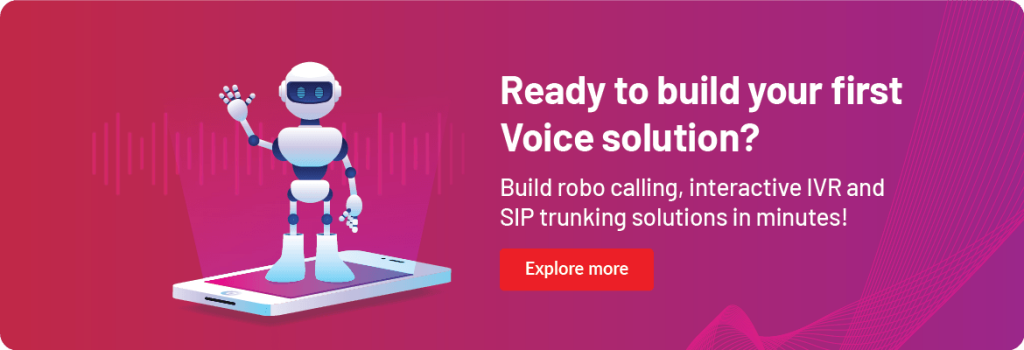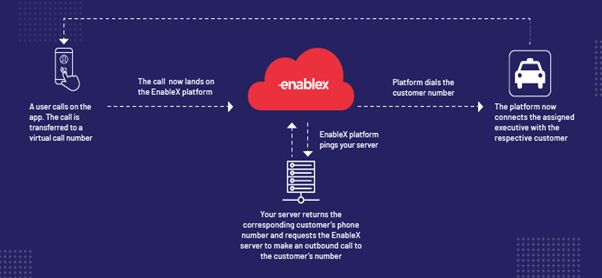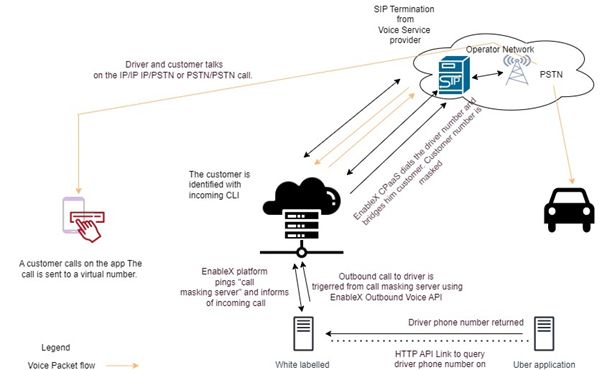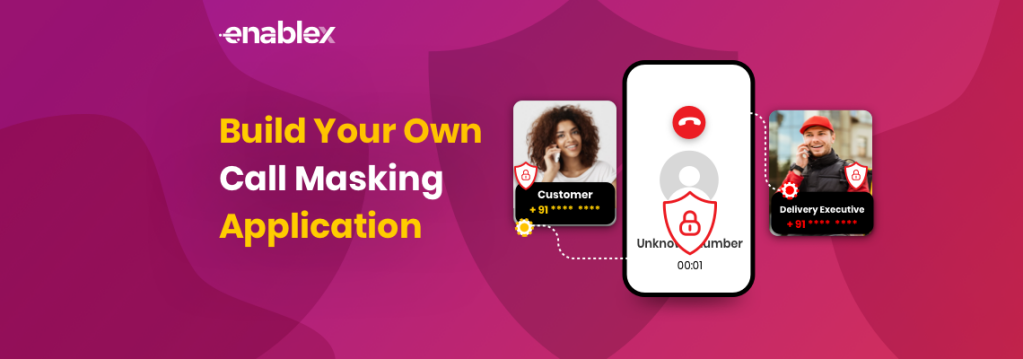Call masking, also referred to as phone number masking, is an effective measure for safeguarding customer identity and preventing the unauthorized use of sensitive information by businesses. This technique involves connecting calls through a temporary proxy phone number, which anonymizes the participating phone numbers. Using EnableX’s voice API, you can easily build an application that meets these requirements.
Call Masking or Phone number masking allows two users to have a conversation without revealing their number to each other. Call masking hides the actual phone number of the caller and displays a different number on the recipient’s phone. The masked number can be a virtual number, a random number, or a number provided by the call masking service.
Features of EnableX’s Call Masking API
EnableX call masking works by using Virtual Number as CLI – “Caller Line Identity”. A virtual number, also known as direct inward dialling (DID) or access numbers, is a telephone number without a directly associated telephone line. Usually, these numbers are programmed to forward incoming calls to one of the pre-set telephone numbers, chosen by the client: fixed, mobile or VoIP.
The EnableX platform also provides an inventory of global virtual numbers post signing up here. Using Enablex Virtual Number as the CLI (Called Line Identity), a business entity can help the users to have a conversation without revealing their number to the other party. Businesses can also enable CNAM (CALLER NAME) on the virtual numbers to help a user identify the call based on the business name, irrespective of the region.
EnableX Voice APIs also allows users / businesses to initiate, accept, play IVR and bridge the call to the other number which can be used to build Call Masking application.

Understanding EnableX’s Call Masking Technology
Let’s take an example of a cab renting app – like Uber, which wants to implement call masking functionality in its application to connect the customers with drivers.
Because of the regulatory restrictions (for example, in India, the TRAI regulations prohibit IP – PSTN mixing), it needs to connect the the customer-driver over regular phone lines, i.e., PSTN to PSTN connectivity without revealing their personal phone number to each other.
For a pure App-to-App calling also you can use EnableX API and will be covered in a different blog.
Business like Taxi service / food delivery services (or any delivery services) can
integrate Enablex Voice API into their app to connect the user and the service personnel.
Here’s a typical workflow of the Call Masking App:

- User / Driver / delivery personnel who wants to connect with each other can click the call button on the business app.
- This will initiate a call to the inbound virtual number registered for this business app.
- The call first lands on the EnableX platform and then to EnableX Call Masking Server which notifies the business application with caller details (customer /service personnel) over a webhook.
- Next, the call masking application logic invokes an API to the taxi service application server to get the information of mapped customer/service personnel.
- Using the mapped information, the EnableX Call Masking Server initiates a call to the customer/service personnel and once it is answered it merges with the previously received incoming call.
- The customer and the service personnel will have the conversation without knowing each other numbers.
In the whole process, EnableX Virtual Number acts as bridge between the two parties involved for a conversation.
Benefits of call masking for a business and individuals
Call masking is important for several reasons:
- Protect personal information: By using a virtual number for calls, individuals/businesses can keep their personal phone numbers private and protect their information from being revealed to third parties.
- Prevent unwanted calls: Call masking prevents unwanted calls and spam.
- Increase privacy: By using a virtual number, individuals and businesses increase their privacy, as they can control who has access to their actual phone number and when it is used.
- Flexibility: Call masking services typically allow users to switch between different masked numbers, making it easier to manage separate lines of communication for personal and professional use.
Advantages of using EnableX Call Masking over other solutions:
- EnableX provides access to phone numbers across 200+ countries with different vendors.
- It’s easy to integrate APIs across any browser, mobile app and device for jitter free, crystal-clear Voice Calls.
- One can reach customers around the world on any platform like apps, browser, SIP- Enabled device or traditional phones.
- EnableX has multiple deployment options- you can be host the voice function on your private cloud, as a hybrid deployment. It can be consumed as a prebuilt SaaS, or integrated via the EnableX Voice API.
How to build a phone number masking application?
- Sign up for EnableX and create an account.
- Access the Voice API documentation and generate an API key.
- Use the API to initiate, accept, play IVR, and bridge the call to another number.
- Choose a virtual number as CLI (called line identity) for the call. EnableX platform provides an inventory of global virtual numbers which can be requested from its portal once you are signed in. Using Enablex virtual Number as the CLI (Called Line Identity) a business entity can help the users to have the conversation without revealing their number to the other party .
- Business can also enable CNAM (CALLER NAME) on the virtual numbers to help user identify the call based on the business name irrespective of the region. Configure the API to enable CNAM (caller name) on the virtual numbers to help users identify the call based on the business name, irrespective of the region.
- Integrate the API into your application to connect the user and the service personnel.
- When a user clicks on the call button on the app, the call is initiated to the inbound virtual number registered for the business app.
- The call lands on the EnableX platform and then to EnableX Call Masking Server, which notifies the business application with caller details (customer/service personnel) over a webhook.
- The call masking application logic invokes an API to the taxi service application server to get the information of the mapped customer/service personnel.
- Using the mapped information, the EnableX Call Masking Server initiates a call to the customer/service personnel and merges it with the previously received incoming call.
- The customer and the service personnel will have the conversation without knowing each other’s numbers.
- To summarize, the steps to build a phone number masking application using EnableX’s voice API involve generating an API key, choosing a virtual number as CLI, and integrating the API into your application. Once the API is integrated, the user and the service personnel can have a conversation without revealing their numbers to each other.
Detailed technical architecture of a call masking application:

Use Cases for Call Masking with EnableX
Online Marketplaces: Online marketplaces such as e-commerce platforms, job portals, and rental websites can use EnableX’s voice API to enable buyers and sellers to communicate with each other while keeping their phone numbers private. This will enhance the privacy and security of both parties and reduce the chances of fraudulent activities.
On-Demand Services: On-demand service providers such as food delivery, ride-hailing, and home services can use EnableX’s voice API to mask the phone numbers of both the service providers and the customers. This will protect the privacy of both parties and provide a safer environment for communication.
Banking and Finance: Banking and financial institutions can use EnableX’s voice API to provide secure communication between their agents and customers. This will enable them to verify the identity of their customers without revealing their phone numbers.
Healthcare: Healthcare providers can use EnableX’s voice API to provide secure communication between doctors, nurses, and patients. This will protect the privacy of patients and ensure that their sensitive medical information is not exposed.
Real Estate: Real estate agents can use EnableX’s voice API to enable buyers and sellers to communicate with each other while keeping their phone numbers private. This will enhance the privacy and security of both parties and reduce the chances of fraudulent activities.
In summary, EnableX’s voice API call masking functionality can be used in various industries to enhance privacy and security and provide a safer environment for communication between parties. To learn more, visit our voice API documentation here.


